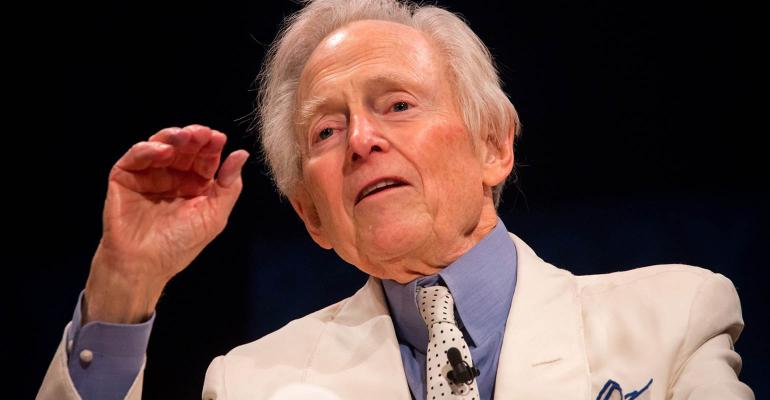(Bloomberg Opinion) -- Watching the new Tom Wolfe documentary, Radical Wolfe, I was reminded of the key role the author and journalist played in the development of quantitative finance. Academics trace the beginning of the field to research in the 1950s that would result in innovations like the capital asset pricing model in the 1960s and the Black-Scholes option pricing model in the 1970s. But those results would take decades to translate into financial practice.
Financial quants start their history in January 1961 when mathematics professor Edward Thorp gave a talk at the American Mathematical Society entitled “Fortune’s Formula,” outlining the secret for winning at blackjack.
Tom Wolfe, then a reporter for the Washington Post, had come across Thorp earlier and wrote a story about his upcoming talk, drawing the attention of the gambler who would bankroll Thorp as he went about proving his theory. That would lead to the publication of Thorp’s bestseller Beat the Dealer. Thorp capitalized on this early success to invent or perfect as a hedge fund manager in the 1960s nearly all the quantitative trading strategies in use today. All this was long before the first tangible academic product of quant research — the index fund — was launched, and before Fischer Black and Myron Scholes published the option pricing model that Thorp had been using to trade.
Wolfe’s article on Thorp had features that would become his trademarks — witty skewering (although gentle in Thorp’s case) and real understanding. Wolfe took the trouble to learn from Thorp the key point for quants: the secret was not the small mathematical edge a blackjack player could get from counting cards, but “fortune’s formula” – derived from the work of Thorp’s Bell Labs colleague John Kelly — that provided a mathematical tool for converting arbitrarily small edges into arbitrarily large fortunes. Quants have always found it easy to identify small mathematical edges, Thorp was the first to teach and then prove the quant article of faith: It was mathematical discipline, not big edges, that led to victory.
Another early Wolfe discovery was Jim Simons, a mathematician and founder of the absurdly successful quant hedge fund Renaissance Capital. Unlike tell-all quant Thorp, who gave away his trading secrets in the 1967 bestseller Beat the Market, Simons was intensely secretive and, despite extraordinary success, managed to escape much public notice until the early 2000s.
But quants knew all about Simons back in the early 1980s when it first became acceptable for Wall Street candidates to include math courses on their resumes and Lewis Ranieri, head of mortgage trading at Solomon Brothers, famously said, “Mortgages are mathematics” — a stunning claim at the time, although too obvious to say today. As Wolfe wrote of the non-quant, arrogant frat-boy salespeople, deal-makers and traders who dominated old Wall Street, “Our manly Masters, still gorged with so much testosterone and dopamine, just didn’t get it when the most unlikely thing in the world happened: a bunch of weaklings, a bunch of nerds known as quants, shut the golden door flat in their faces.”
Wolfe would go on to write the great American financial novel, Bonfire of the Vanities, satirizing and immortalizing the excesses of 1980s Wall Street. The era inspired much fiction, with Gordon Gekko as its most famous character. But no other successful fiction author bothered to go to the trading floor and see what things looked like to quants on the inside. In over four decades on Wall Street, I’ve never met anyone remotely like Gordon Gekko, Bobby Axelrod or a host of other fictional titans, but I’ve known many Sherman McCoys — the protagonist of Bonfire of the Vanities. Wolfe captured not just the emotions and culture of the trading floor, he actually understood and described what was going on beneath the shouting and numbers flashing on computer screens.
The other authors who capture some of the insider reality of quant finance work — such as Michael Lewis and Bloomberg Opinion columnist Matt Levine — write non-fiction. Valuable as this is, Wolfe’s fictional work — including his second novel, A Man in Full — combine accurate insider accounts of quant finance with broader human and social considerations.
Financial quants remember Wolfe as a reporter covering the birth of their field in 1961, and for his 2013 essay, Eunuchs of the Universe, summarizing the subsequent half century and noting that much of the quant revolution energy had moved to Silicon Valley (which Wolfe was reporting on as early as 1983, long before financial interest in information technology exploded in the mid-1990s). In between, his fiction skewered their work, but with wit, sympathy and understanding.
More From Bloomberg Opinion:
- Capitalism and Liberalism Head Toward Divorce: Adrian Wooldridge
- Widening Wealth and Inequality Gaps Have Limits: Aaron Brown
- Ray Dalio Closes the Frontier for Hedge Funds: Aaron Brown
Want more Bloomberg Opinion? OPIN <GO>. Or you can subscribe to our daily newsletter.





